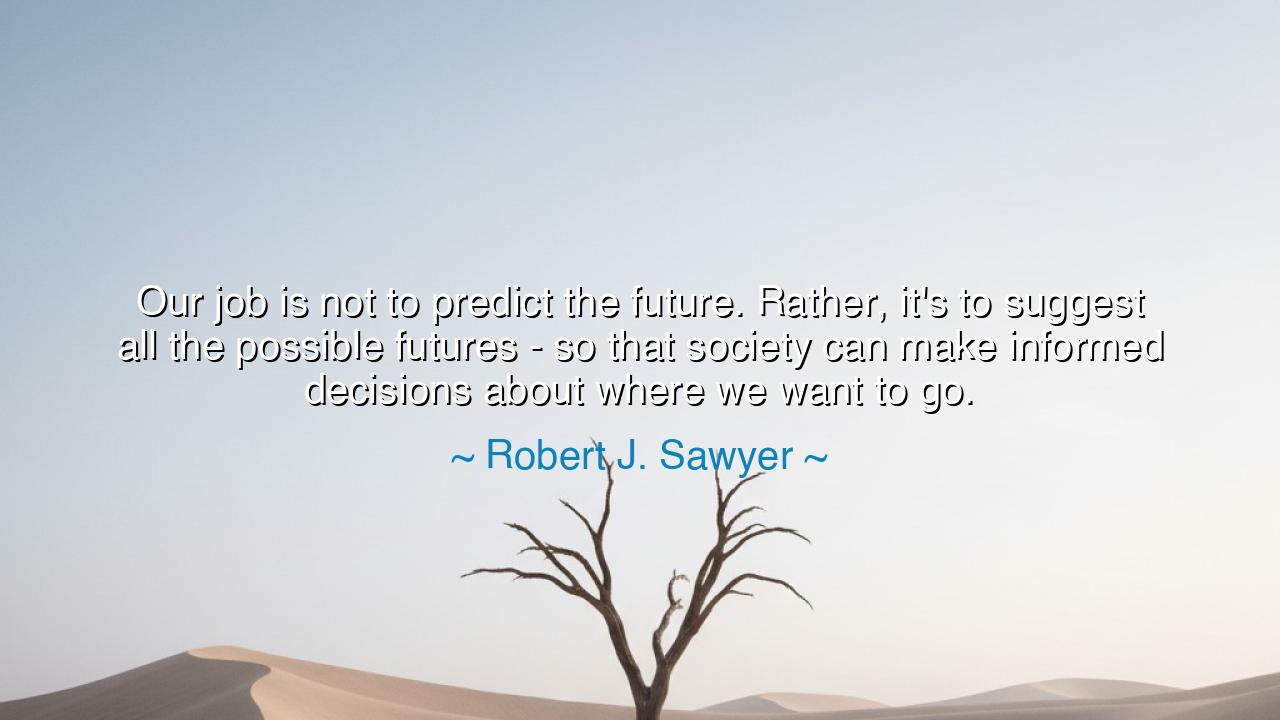
Our job is not to predict the future. Rather, it's to suggest all
Our job is not to predict the future. Rather, it's to suggest all the possible futures - so that society can make informed decisions about where we want to go.






"Our job is not to predict the future. Rather, it's to suggest all the possible futures - so that society can make informed decisions about where we want to go." With these words, Robert J. Sawyer offers a powerful reflection on the role of those who shape ideas, stories, and theories about the future. It is not the job of the visionary to offer a singular, predetermined path forward, but rather to illuminate the many paths that lie ahead. The task is to provide a broad spectrum of possibilities, so that society—the collective—can deliberate, choose, and walk towards the future with understanding and intent. This teaching challenges us to embrace uncertainty and complexity, understanding that the future is not a single, fixed destination, but a landscape of possibilities awaiting exploration.
In ancient times, the role of the seer or oracle was similar in its responsibility. The oracle at Delphi, for instance, was not tasked with providing a clear, unambiguous future, but rather with offering guidance through symbolic messages that required careful interpretation. The future, as it were, was a tapestry of possibilities, woven with threads of fate, choice, and circumstance. The purpose of the oracle was not to reveal one definitive outcome but to help those seeking wisdom to understand the uncertainty of their path and the responsibility they held in shaping their own destinies. In this way, Sawyer’s philosophy is timeless—it speaks not only to our present moment, but to the eternal human quest to understand what lies ahead.
Consider the example of Leonardo da Vinci, whose genius lay not in his ability to predict the future, but in his incredible imagination. Da Vinci envisioned flying machines, armored tanks, and endless innovations that were far beyond the technology of his time. He was not merely a prophet of the future, but a visionary who suggested a vast range of possibilities for humanity, some of which would come to fruition centuries after his death. His work did not provide answers to the future, but it opened doors—a collection of ideas, inventions, and principles that would eventually inspire future generations to choose their own direction. In this, Da Vinci embodied the very essence of Sawyer’s message: it is not for us to foretell the future, but to suggest all the possibilities so that humanity may freely decide which path to follow.
The lesson we can draw from this is that uncertainty is not something to fear, but to embrace. The future is not a monolithic entity but a series of branching possibilities, each shaped by the decisions we make in the present. In times of change, we often look to the future with fear or anticipation, hoping for clear guidance or a fixed answer. Yet, as Socrates reminded us, it is not the certainty of the future that matters, but the wisdom we employ in the present to navigate the complexity of life. Our role, then, is to offer not predictions, but insights—not a narrow vision of the future, but a vast array of options for society to choose from.
Look at the example of Albert Einstein, whose theories of relativity transformed our understanding of space, time, and the universe itself. Einstein did not provide a roadmap for how humanity should use his discoveries, nor did he offer a clear vision of the future. Rather, he proposed new ways of thinking—new frameworks that would change the very nature of reality. In this way, Einstein’s legacy mirrors that of Sawyer’s vision. He did not tell society what to do with his ideas; he merely opened up new realms of possibility. Similarly, in our own lives, we are tasked not with knowing the future, but with understanding the present deeply enough to shape the multitude of futures that lie ahead.
The lesson for us today is to embrace the complexity of our world. We are not meant to be seers of fixed outcomes, but guides who help illuminate the possibilities before us. Each of us has the power to contribute to a vision of the future, not by providing one singular answer, but by offering a wide range of potential paths. Whether in the realms of science, politics, art, or personal growth, we must acknowledge that the future is not a set destination, but a journey with countless directions. The more we encourage divergent thinking, innovation, and choice, the better equipped we will be to navigate whatever lies ahead.
In practical terms, this means that we must all become contributors to the future—not by giving answers, but by expanding the possibilities available to us. Instead of holding rigidly to a singular vision of what the future should look like, let us embrace the beauty of multiple pathways, each shaped by the values and decisions we make today. Encourage debate, creativity, and collaboration, so that we can collectively shape the future in a way that is thoughtful, inclusive, and rich with possibilities. Do not fear the unknown, but see it as a vast canvas on which we can all contribute our unique colors and brushstrokes. The future, after all, is not predetermined—it is what we make of it.






AAdministratorAdministrator
Welcome, honored guests. Please leave a comment, we will respond soon